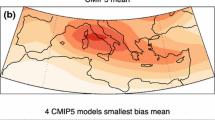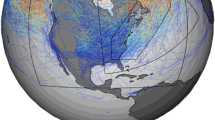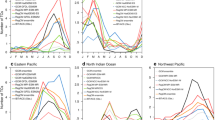Abstract
The North American Regional Climate Change Assessment Program (NARCCAP) represents the next step in investigating the behavior of weather phenomena in current and future climate. Specifically, variations in mid-latitude cyclone tracks attributable to a warming climate have potential socio-economic consequences via the redistribution of precipitation on regional spatial scales. This manuscript assesses the impacts of a warming climate on cyclone tracks in the NARCCAP model suite. Specifically, cyclones are generated from eight 33-year simulations for the twentieth Century (1968–2000) and eight 33-year simulations for the A2 greenhouse scenario (2068–2100). To provide comparison, cyclone tracks are also generated from the Climate Forecast System Reanalysis (CFSR) and ERA Interim (ERA_INT) reanalysis datasets from 1979 to 2016. The results support that the NARCCAP model suite is capable of producing a reasonable cyclone frequency and intensity climatology when compared with the reanalysis datasets. Comparison of the ensemble twentieth Century cyclone (20C) tracks with the ensemble A2 cyclone tracks demonstrate a zonally-oriented poleward shift in cyclone track frequency in response to a warming climate. Intensity differences were regionally oriented, with cyclones being more intense in the A2 relative to the twentieth Century scenarios west of the Appalachians, suggesting cyclones acquire greater latent heat from warmer western Atlantic/Gulf of Mexico moisture sources in A2. A sector analysis revealed a higher total frequency of cyclones in both reanalysis datasets relative to either NARCCAP scenario. For intense cyclones, the NARCCAP model simulations produced more frequent cyclones in the Great Lakes and East Coast sectors. In contrast, reanalysis produced a higher frequency of weak cyclones for all sectors except Atlantic Canada. In addition, NARCCAP simulations were found to be capable of reproducing the broadness of intensity distributions in the reanalysis datasets, likely due to the fine spatial gridding in the NARCCAP models. Sector analysis for frequency and intensity affirmed the ensemble results, with individual model simulations showed a reduction in frequency for all sectors except the Canadian Maritimes for A2 relative to 20C. For intensity, cyclones were once again overall more intense for the upper Midwest/Great Lakes sector for A2 relative to 20C. The results of this research demonstrates the ability for regional climate models to be used to assess changes in synoptic-scale phenomena in a warming climate. Future work will focus on assessing cyclone structure including changes in moisture transport, precipitation, and the low-level jet.















Similar content being viewed by others
References
Bengtsson L, Hodges KL, Keenlyside N (2009) Will extratropical cyclones intensify in a warmer climate. J Clim 22:2276–2301
Benjamini Y, Hochberg Y (1995) Controlling the false discovery rate: a practical and powerful approach to multiple testing. J R Stat Soc 57B:289–300
Catto JL, Shaffrey LC, Hodges KL (2010) Can climate models capture the structure of extratropical cyclones? J Clim 23:1621–1635
Chang EK (2013) CMIP5 projection of significant reduction in extratropical cyclone activity over North America. J Clim 26:9903–9922. https://doi.org/10.1175/jcli-d-13-00209.1
Chang EKM, Fu YF (2003) Using mean flow change as a proxy to infer interdecadal storm track variability. J Clim 16:2178–2196
Chang EK, Guo Y, Xia X (2012) CMIP5 multimodel ensemble projection of storm track change under global warming. J Geophys Res 117:D23118. https://doi.org/10.1029/2012jd018578
Chang EK, Guo Y, Xia X, Zheng M (2013) Storm-track activity in IPCC AR4/CMIP3 model simulations. J Clim 26:246–260
Catto JL, Shaffrey LC, Hodges KI (2011) Northern Hemisphere extratropical cyclones in a warming climate in the HiGEM high-resolution climate model. J Clim 24:5336–5352. https://doi.org/10.1175/2011JCLI4181.1
Colle BA, Zhang Z, Lombardo KA, Chang E, Liu P, Zhang M (2013) Historical evaluation and future prediction of eastern North American and western atlantic extratropical cyclones in the CMIP5 models during the cool season. J Clim 26:6882–6903
Dee DP et al (2011) The ERA-Interim reanalysis: configuration and performance of the data assimilation system. Q J R Meteorol Soc 137:553–597
Eichler T, Higgins W (2006) Climatology and ENSO-related variability of north american extratropical cyclone activity. J Clim 19:2076–2093
Eichler TP, Gaggini N, Pan Z (2013) Impacts of global warming on Northern Hemisphere winter cyclone tracks in the CMIP5 model suite. J Geophys Res Atmos. https://doi.org/10.1002/jgrd.50286
Gelaro R et al (2017) The modern-era retrospective analysis for research and applications, Version 2 (MERRA-2). J Clim. https://doi.org/10.1175/JCLI-D-16-0758
Geng Q, Sugi M (2003) Possible change of extratropical cyclone activity due to enhanced greenhouse gases and sulfate aerosols—study with a high-resolution AGCM. J Clim 16:2262–2274
Hoskins BJ, Hodges KI (2002) New perspectives on the northern hemisphere winter storm tracks. J Atmos Sci 59:1041–1061
Jiang J, Perrie W (2007) The impacts of climate change on autumn North Atlantic midlatitude cyclones. J Clim 20:1174–1187
Kobayashi S, Ota Y, Harada Y, Ebita A, Moriya M, Onoda H, Onogi K, Kamahori H, Kobayashi C, Endo H, Miyaoka K, Takahashi K (2015) The JRA-55 reanalysis: general specifications and basic characteristics. J Meteor Soc Jpn 93:5–48. https://doi.org/10.2151/jmsj.2015-001
Lehmann J, Coumou D, Frieler K, Eliseev AV, Levermann A (2014) Future changes in extratropical cyclone tracks and baroclinicity under climate change. Environ Res Lett 9:084002
Livezey RE, Chen WY (1983) Statistical field significance and its determination by Monte Carlo techniques. Mon Weather Rev 111:46–59. https://doi.org/10.1175/1520-0493(1983)111%3c0046:SFSAID%3e2.0.CO;2
Mbengue C, Schneider T (2017) Storm-track shifts under climate change: toward a mechanistic understanding using baroclinic mean available potential energy. J Atmos Sci 74:93–110
Mearns LO et al (2012) The North American Regional Climate Change Assessment Program dataset, National Center for Atmospheric Research Earth System Grid data portal, Boulder, CO. https://doi.org/10.5065/d6rn35st
Meehl G et al (2007) Global climate projections. In: Solomon S et al (eds) Climate change 2007: the physical basis. Cambridge University Press, Cambridge, pp 747–845
Nakicenovic et al (2000) Special Report on Emissions Scenarios. A Special Report of Working Group III of the Intergovernmental Panel on Climate Change. Cambridge University Press, Cambridge
Pinto JG, Ulbrich U, Leckebusch GC, Spangehl T, Reyers M, Zacharias S (2007) Changes in storm track and cyclone activity in three SRES ensemble experiments with the ECHAM5/MPI-OM1 GCM. Clim Dyn 29:195–210
Poan ED, Gachon P, Laprise R, Aider R, Dueymes G (2018) Investigating added value of regional climate modeling in North American winter storm track simulations. Clim Dyn 50:1799–1818. https://doi.org/10.1007/s00382-017-3723-9
Raible CC, Della-Marta P, Schwierz C, Wernli C, Blender R (2008) Northern hemisphere extratropical cyclones: a comparison of detection and tracking methods and different reanalyses. Mon Weather Rev 136:880–897
Rohrer M, Bronnimann S, Martius O, Raible C, Wild M, Compo G (2018) Representation of extratropical cyclones, blocking anticyclones, and alpine circulation types in multiple reanalyses and model simulations. J Clim 31:3009–3031
Saha S, Moorthi S, Panetal H-L (2010) 2010: the NCEP climate forecast system reanalysis. Bull Am Meteorol Soc 91(8):1015–1057
Seiler C, Zwiers FW (2016) How well do CMIP5 climate models reproduce explosive cyclones in the extratropics of the Northern Hemisphere? Clim Dyn 46:1241–1256
Seiler C, Zwiers FW, Hodges KI, Scinocca JF (2017) How does dynamical downscaling affect model biases and future projections of explosive extratropical cyclones along North America’s Atlantic coast? Clim Dyn. https://doi.org/10.1007/s00382-017-3634-9
Serreze MC (1995) Climatological aspects of cyclone development and decay in the Arctic. Atmos Ocean 33:1–23
Serreze MC, Carse F, Barry RG, Rogers JC (1997) Icelandic low cyclone activity: climatological features, linkages with the NAO and relationships with recent changes in the northern hemisphere circulation. J Clim 10(3):453–464
Simmonds I, Keay K, Eun-Pa LIM (2003) Synoptic activity in the seas around Antarctica. Mon Weather Rev 31:272–288
Taylor KE, Stouffer RJ, Meehl GA (2012) An overview of CMIP5 and the experimental design. Bull Ame Meteorol Soc 93:485–498. https://doi.org/10.1175/BAMS-D-11-00094.1
Uccellini (2016) The Historic Nor’easter of January 2016. NOAA Service Assessment
Ulbrich U, Leckebusch GC, Pinto JG (2009) Extra-tropical cyclones in the present and future climate: a review. Theor Appl Climatol 96:117–131
Ventura V, Paciorek CJ, Risbey JS (2004) Con-trolling the proportion of falsely rejected hypotheses when conducting multiple tests with climatological data. J Clim 17:4343–4356. https://doi.org/10.1175/3199.1
Wang J, Kim H-M, Chang EKM (2017) Changes in Northern hemisphere winter storm tracks under the background of arctic amplification. J Clim 30:3705–3724
Watterson IG (2006) The intensity of precipitation during extratropical cyclones in global warming simulations: a link to cyclone intensity? Tellus 58A:82–97
Wilks DS (2006) On “field significance” and the false dis-covery rate. J Appl Meteorol Climatol 45:1181–1189. https://doi.org/10.1175/JAM2404.1
Wilks DS (2016) The stippling shows statistically significant gridpoints”: how research results are routinely overstated and over-interpreted, and what to do about it. Bull Am Meteorol Soc 97:2263–2273. https://doi.org/10.1175/BAMS-D-15-00267.1
Willison J, Robinson WA, Lackmann GM (2015) North Atlantic storm-track sensitivity to warming increases with model resolution. J Clim 28(11):4513–4524
Yang M, Li X, Zuo R, Chen X, Wang L (2018) Climatology and interannual variability of winter North Pacific storm track in CMIP5 models. Atmosphere 9:79. https://doi.org/10.3390/atmos9030079
Yin JH (2005) A consistent poleward shift of the storm tracks in simulations of 21st Century climate. Geophys Res Lett 32:L18701. https://doi.org/10.1029/2005GL023684
Zappa G, Shaffrey LC, Hodges KI (2013) The ability of CMIP5 models to simulate North Atlantic extratropical cyclones. J Clim 26:5379–5396
Acknowledgement
The author wishes to thank Dr. Patrick Market from the University of Missouri for reviewing the manuscript and providing commentary.
Funding
This work was supported by the United States NSF EPSCoR Grant Award IIA-1355406. Any opinions, findings, conclusions, or recommendations expressed here are those of the author and do not necessarily reflect the views of NSF.
Author information
Authors and Affiliations
Corresponding author
Additional information
Publisher's Note
Springer Nature remains neutral with regard to jurisdictional claims in published maps and institutional affiliations.
Electronic supplementary material
Below is the link to the electronic supplementary material.
Rights and permissions
About this article
Cite this article
Eichler, T.P. The impacts of a warming climate on winter mid-latitude cyclones in the NARCCAP model suite. Clim Dyn 54, 4379–4398 (2020). https://doi.org/10.1007/s00382-020-05236-z
Received:
Accepted:
Published:
Issue Date:
DOI: https://doi.org/10.1007/s00382-020-05236-z




